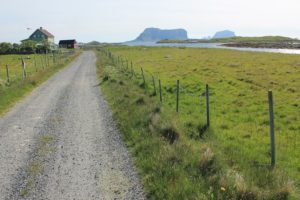
I always long for spring. Sheep gracing, newborn lambs calling, a constant chorus of horny and hungry birds…The cooing, gak gak gak and hooing of the Common Eiders. This spring we had a very loud and joyful Willow warbler on Grimsøya.
But even this is not a spring chorus if you would compare it to 50 or 70 years back. The decline of the Common Eiders is caused by food shortage in the Ocean, marine garbage, and various disturbances.
Grimsøya is situated on the SouthWesternmost habited area on Røst. I have been so grateful and humbled to be living here in the “Margrethe house”, since 2015.
Grimsøyas etymology or “Grems-øya” as the dialect goes, indicates a very long patch of tidal zone; which describes it well.
In the old days, the Kittiwakes of Vedøya would fly in overland here towards the freshwater ponds of Øran and Ystøra. There were 500 Common Eide nests here, which the locals would look after and cater for by preparing nests each spring. The female Eider will lay up to three eggs. It is only when she has laid her third egg that she stays permanently on the nest. She will pluck the soft, insulating downs of her chest to cover the eggs. When the chicken’s hatch and the Eider have to lead all the chicks down to the seaside where they will spend most of their young and adult life, the humans on Grimsøya would kill all predator birds chasing the Eiders. And when the Eider had left the nest, the human would pick the down and begin the rather meticulous process of rinsing it. The down was used in duvets and hats and a very lucrative. product to sell. So important Røst currency.
This autumn Gudrun Jørgensen passed away, 91 years old. She has been looking after Eider nests on Grimsøya for half of her life. You can read an article about her and her and other Common Eider nest protectors in the newspaper Klassekampen:
“At Røst, Jørgensen has the honorary title «eider-mother». The garden around the 88-year-old’s green house is a safe haven for the Eider pairs. Along the house walls, the nest boxes are close together, and under the stairs there is a fixed pair that nests. She can not imagine a summer without the cooing around the house. When she and her husband moved to Røst in 1950, they took over responsibility for this downpour. Since then, they have carefully arranged, given the bird’s security and picked the down for sale. Jørgensen takes her responsibility for the Eider seriously. When the nesting starts, she chases away gulls and eagles that want to forage their eggs, and unnecessary noise from summer guests is not allowed. The female Eider lies on the eggs for 21 days, and for Gudrun, the highlight of the summer comes when the mother Eider sways proudly towards the sea, followed by up to five little ones. The father stays close and follows up on the family.”